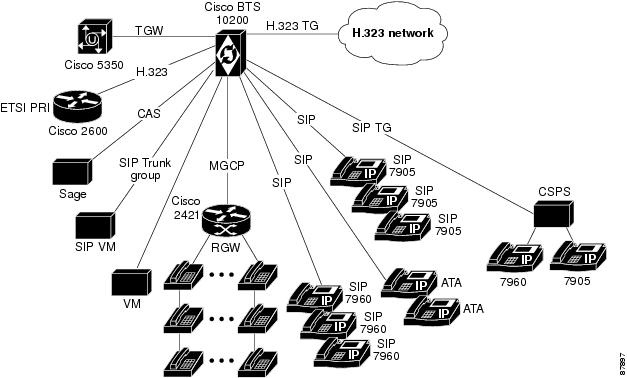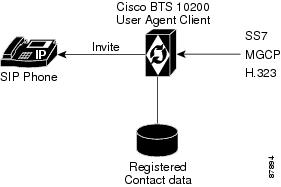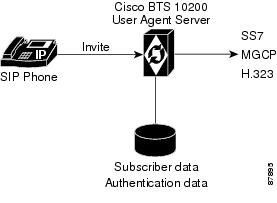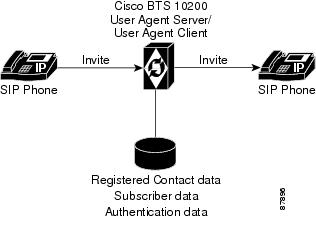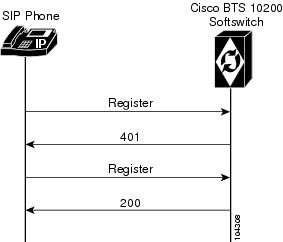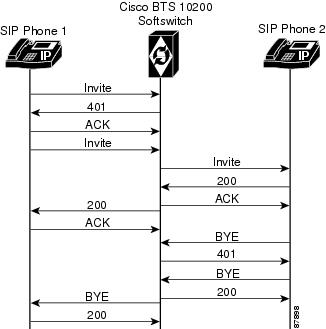

Table Of Contents
SIP Roles Played by Cisco BTS 10200 Softswitch
Limitation On Treatment of Transient Calls
User Agent Client and User Agent Server
New or Enhanced SIP Subscriber Features for Release 4.5.x
Other Common Subscriber Features
Limitations on Number of URLs, Parameters, and Headers (Release 4.5.1, Maintenance Release 2)
SIP Devices Support Overview
Revised: May 3, 2007, OL-5352-12The purpose of this guide is to detail the Session Initiation Protocol (SIP) device support, and the changed trunk support in Release 4.5.x. Support for SIP trunks existed in previous releases of the Cisco BTS 10200 Softswitch, but support for SIP devices was new in Release 4.1. The user guide covers areas impacted by the SIP feature, and is an addition to the existing Cisco BTS 10200 Softswitch documentation.
Note
The term "SIP devices" refers to Cisco ATA 186/188 adaptors, and to Cisco IP phones.
The SIP support feature provided in Release 4.5.x was built on the existing Cisco BTS 10200 Softswitch software and hardware platform. The user guide describes the features and protocol changes in Cisco BTS 10200 Release 4.5.x for supporting SIP trunks and subscribers.
The Cisco BTS 10200 Softswitch complex includes a Call Agent (CA), Feature Server (FS), Element Management System (EMS), and an optional HTTP feature server (HTTP-FS) which is comprised of a GUI Feature Server (GUI-FS) and Mini-Browser Adapter (MBA). In this book, all references to the term "Cisco BTS 10200" refer to the Call Agent unless otherwise specified.
SIP protocol support for subscriber features is provided by the Call Agent and the POTS Feature Server.
The Cisco BTS 10200 Softswitch uses SIP and SIP for telephones (SIP-T) signaling to communicate with other SIP-based network elements. The implementation is based upon the evolving industry standards for SIP, including IETF document RFC 3261, SIP: Session Initiation Protocol. The Cisco BTS 10200 Softswitch supports both SIP trunks and SIP-based subscriber lines (SIP devices), and provides the following SIP-related functions:
•
Protocol conversion between SIP and several other protocols, including SS7, PRI, ISDN, H.323, MGCP, and CAS.
•
Tandem back-to-back user agent for direct SIP-to-SIP calls (trunk to trunk, phone to phone, and trunk to/from phone), and SIP-to-SIP-T calls.
•
SS7 bridging between Softswitches using SIP-T methods.
•
Native support of SIP endpoints such as SIP phones, including authentication and registration management. (For example, the Cisco BTS 10200 Softswitch maintains the current location of SIP subscribers.)
The Cisco BTS 10200 Softswitch provides billing data for SIP calls. Specific fields are supported in the call detail records for calls that originate or terminate on a SIP trunk or subscriber. For detailed information on these fields, including billing management and data, refer to the Cisco BTS 10200 Softswitch Billing Interface Guide.
SIP Roles Played by Cisco BTS 10200 Softswitch
Figure 1-1 shows the new Cisco BTS 10200 Softswitch architecture with native support for SIP phone subscribers. In addition to its existing capabilities, in this new architecture, Cisco BTS 10200 provides Registrar (with SIP user authentication) services.
The Cisco BTS 10200 Softswitch supports call processing for SIP trunks and phone users. As a result of native SIP subscriber support, SIP subscribers can use features formerly available only to MGCP subscribers.
For a comparison of the MGCP and SIP feature support, see "MGCP Features vs. SIP Features."
Figure 1-1 Cisco BTS 10200 Softswitch Network Architecture
SIP roles performed by the Cisco BTS 10200 Softswitch include:
•
User agent server (UAS)
•
User agent client (UAC)
•
Registrar
Note
The Cisco BTS 10200, as part of the Back-to-Back functionality, plays the role of the UAS and UAC.
Most features provided by the SIP phones comply with LATA Switching Systems Generic Requirements (LSSGR), depending on the phone implementation and capabilities. Due to the nature of the SIP protocol, however, your experience with a feature may differ from what is documented in the LSSGR for that feature.
Limitation On Treatment of Transient Calls
If the active Call Agent experiences a problem and switches over to the standby side, stable calls are preserved. However, calls that are in a transient state (call setup is not complete) might be dropped or improperly set up. During a Call Agent switchover, the Cisco BTS 10200 Softswitch cannot complete call setup for these transient calls.
Transient calls and inactive connected calls originated on the Cisco BTS 10200 Softswitch are cleaned up through a periodic audit mechanism that runs once per hour. The frequency of this audit can be modified. However, changing this requires careful consideration to avoid adverse effects on call processing. Contact Cisco TAC if you have identified a need to change this frequency.
SIP Phone Registrar
SIP Register support enables SIP devices to be served by Cisco BTS 10200 directly without a proxy. The Cisco BTS 10200 acts as a Registrar and authenticates the SIP request.
To initiate a session with a SIP phone, Cisco BTS 10200 must know the current address of the phone. Registration creates bindings in a location service for a particular domain that associate an address-of-record Uniform Resource Identifier (URI) with one or more contact addresses. A user notifies its availability at the address provided in the contact for the specified duration.
The SIP phone registers with Cisco BTS 10200, setting up a binding between the Address of Record (AOR) and its contact address. The registration is valid for a period of time until it expires.
Figure 1-2 demonstrates the SIP phone Registrar function.
Figure 1-2 SIP Phone Registrar Function
Cisco BTS 10200 supported SIP subscribers with SIP phones starting in Release 4.1. SIP users register with Cisco BTS 10200 and originate calls through Cisco BTS 10200. To identify the SIP user, Cisco BTS 10200 uses the challenge-based Digest Access Authentication.
User Agent Client and User Agent Server
The User Agent is a SIP endpoint (such as a phone or a gateway). In this scenario, the User Agent is software running on the endpoint to enable SIP service.
The User Agent can work either as a client or server. When a call is placed, the User Agent Client (UAC) places the request, and the User Agent Server (UAS) services the request and sends a suitable response. The roles change continually, however; for example, with call hold, either user can put the other user on hold.
Figure 1-3 shows the Cisco BTS 10200 working as a UAC, sending out a call request.
Figure 1-3 User Agent Client
Figure 1-4 shows the Cisco BTS 10200 working as a UAS, accepting a call request.
Figure 1-4 User Agent Server
Back-to-Back User Agent
The back-to-back user agent acts as a UAC and UAS for a single call. It keeps the two call segments separate on the Cisco BTS 10200 Softswitch. Typically, a proxy routes a call, but does not act as a User Agent. The Cisco BTS 10200 acts as a User Agent. In a call between two SIP endpoints (such as SIP phone or SIP trunk), Cisco BTS 10200 terminates the originating half of the call, playing the UAS role, and then sets up the terminating half of the call as a UAC.
Note
There is no provisioning associated with the back-to-back functionality. The Cisco BTS 10200 automatically acts as a back-to-back user agent for a SIP to SIP call.
Figure 1-5 shows the Cisco BTS 10200 working as a back-to-back user agent.
Figure 1-5 Back-to-Back User Agent Server
Figure 1-5 shows the call flow for registration.
Figure 1-6 Call Flow for Registration
Figure 1-7 shows the call flow for a back-to-back User Agent.
Figure 1-7 Back-to-Back User Agent Call Flow with Authentication
SIP Subscriber Features
SIP Subscriber features are categorized as follows:
•
Cisco BTS 10200 Softswitch-Based Features—These are provided entirely by the Cisco BTS 10200, and require suitable provisioning of the Cisco BTS 10200.
•
Phone-Based Features—These are provided exclusively by the phone, which require provisioning on the phone.
•
Jointly-Provided Features—These are provided jointly. The features are provided partly by the phone's capability, and partly by Cisco BTS 10200 capabilities. To use these features, you must provision both the phone and the Cisco BTS 10200.
New or Enhanced SIP Subscriber Features for Release 4.5.x
Table 1-1 lists the new or enhanced SIP features supported in Release 4.5.x.
Table 1-1 New Cisco BTS 10200 Softswitch-Based SIP Features
T.38 Fax Relay Call Agent Controlled Mode Across SIP Trunk Interface
In previous releases, Cisco BTS 10200 partially supported T.38 fax relay call agent controlled mode in MGCP and H.323 trunk interfaces. Release 4.5.x offers supports for the PacketCable environment, as well as extending T.38 fax support to SIP, NCS, and TGCP trunk interfaces.
Refer to the T.38 Fax Relay feature module.
Secure Provisioning for SIP Endpoints
Enhanced SIP Registration was added to Release 4.5.x to ensure that a SIP REGISTER message to the Cisco BTS 10200 is from a provisioned endpoint. The feature also ensures that the source IP address and contact parameter for all originating calls is from the provisioned SIP endpoint, and that no calls can originate from an unregistered endpoint.
Refer to the Secure Provisioning for SIP Endpoints feature module.
SIP Session Timers
SIP Session Timer values configured prior to Release 4.5.x are reset to the default values after upgrading to Release 4.5.x.
Refer to SIP Timer Values for an overview description.
For provisioning information, refer to Session Timers in the Cisco BTS 10200 SIP Provisioning Guide.
SIP Dynamic Memory Audit
Refer to SIP Dynamic Memory Audit for a more in-depth description.
Also, refer to the Activity table section in the Cisco BTS 10200 Command Line Interface Reference Guide.
SIP Transport
When a 503 response is received, the entity receiving the response proceeds by submitting the same request as a new transaction (with new branch ID) to the next IP address in the SRV list. Previously, when SIA received the 503 response, it tore down the call.
As a result, some calls may not have completed if one of the nodes in an SRV list returned the 503, while other nodes in the list were capable of handling the request successfully.
If an SRV server receiving the INVITE does not respond within the retransmission timer period, this enhancement allows for configuring the Cisco BTS 10200 to send the next retransmission of the same request to either the same server (as recommended in RFC3263) or the next server in the SRV list (legacy Cisco BTS 10200 behavior) using a provisionable flag DNS_SRV_ADV_ON_RETRANS_TIMEOUT on the SOFTSW-TG-PROFILE table.
INVITE Retries Are Configurable
The SIP protocol adapter enables the configuration of the number of INVITE and non-INVITE retries on timer expiry (instead of the fixed 6), and also makes the retry timers configurable. This improves route advancing and completes calls more quickly if one IP address is down.
SIP timers are configurable on a per trunk basis, or on a system wide basis for all non-trunk messages. The number of retries and retry interval could be tuned using RFC3261 timers. The guidelines and recommendations on configuring SIP timers will be available in the Cisco BTS 10200 SIP Protocol User Guide.
The timers are configurable on a global basis through the Softswitch Trunk Group Profile (SOFTSW Trunk Group Profile) and Call Agent Configuration (CA-CONFIG) tables.
Refer to the SOFTSW Trunk Group Profile and CA-CONFIG sections in the Cisco BTS 10200 Command Line Interface Reference Guide.
SIP Retry
SIP responses received from a Re-Invite or Update sent during an active call that contain a Retry-After header invoke the SIA retry mechanism. Currently, this includes only the SIP 500 class response. The check has been expanded to include other responses.
SIP Stack Message Size
Previous to Release 4.5.x, the SIP stack could only send and receive messages up to 1500 bytes in size from the network. If a message was bigger than 1500 bytes, only the first 1500 bytes were read and parsed.
Release 4.5.x fixes the limitation imposed on the maximum size of the SIP messages which can be sent or received. The SIP stack can now receive/send SIP messages up to 3000 bytes in size.
SIP Trunk Hop Counter
The SIP Trunk Hop Counter feature was added into Cisco BTS 10200 Release 4.1, but was not provisionable. However, the feature's provisionable components are available in Release 4.5.x, and are provisionable using the SOFTSW Trunk Group Profile table:
•
HOP-COUNTER-MAX
•
HOP-COUNTER-SUPP
•
MAX-FORWARDS
Note
Seven SIP hops are equivalent to one SS7 hop.
For more information, refer to the SOFTSW Trunk Group Profile section in the Cisco BTS 10200 Command Line Interface Reference Guide.
Cisco BTS 10200 Sends SDP for SIP Call When rbk=N for Call Waiting
When a SIP call inbound to the Cisco BTS 10200 is routed to a local subscriber, and this call causes "call waiting" at the subscriber, the originator is provided local ringback indication. However, in this case, the SIP interface was providing remote ringback indication. This may result in the originator not hearing ringback or possibly the discussion of the other dialog.
The SIP interface was corrected to provide local ringback.
SIA Diversion Header
Previously, when one diversion header was received in the initial SIP Invite message, the Original Called Number (OCN) was populated. To be consistent with other adapters, the value is now copied to the Redirect Number (RDN) as well.
SIP Outbound Numbers Require +CC Depending on NOA
RFC 3398 states that any outbound SIP number with NOA of NATIONAL must be prefixed with "+CCnumber" which is an international format, and any number with NOA=subscriber must be formatted also with international significance. This was not done in previous releases.
Sending Full E.164 is enabled by a flag in softsw-tg-profile to enable interworking with downstream devices that require this number format.
SIP Stack
SIP message loop detection was removed in Release 4.5.x. Previously, the SIP stack did not allow receipt of an un-changed Request URI on hairpinned INVITEs. This required the entity that was hairpinning the SIP call back to Cisco BTS 10200 to modify the user portion of the Request-URI, so that Cisco BTS 10200 does not detect a loop.
Since adding the Digman feature, the digit manipulation is performed within Cisco BTS 10200, thereby preventing a requirement for this check. As such, this check is a configurable option that can be toggled through SIA's configuration file for SIP stack.
DOMAIN-NAME Verified on SIP INVITE Messages
SIP INVITE messages are now validated. This helps detect invalid provisioning or configuration, as well as providing a basic check against intrusion from unauthorized call-agents.
Note
This is applicable to the CP environment only.
An alarm is generated when an invalid SIP INVITE is detected due to an invalid domain name. The event is corrected with the following steps:
1.
Verify the provisioned domain name and the one used by SIM to process the command-line parameter.
2.
Verify the message source, whether it is on-net request or a potential unspoofed intrusion attempt.
A "403 FORBIDDEN MSG" is returned in response to an "INVITE MSG" from an unauthorized/unrecognized CP. The CP processes the call as a basic call.
Due to a change in the Logical IP Migration feature, this feature is suppressed by default in Release 4.5.x. To turn on the DOMAIN NAME validation feature, use the -enable_dnv option included in Args= of the platform.cfg for POTS and ASM.
SIP Stack Attempts Next Address If TCP Connection Fails for INVITE
When provisioning a SIP trunk-grp, the SOFTSW_TSAP_ADDR is usually set to a FQDN that resolves to two or more IP addresses for the destination SIP endpoint(s). Prior to Release 4.5.x, when transmitting a SIP request, if the NON_SRV_TRANSPORT of the softsw-tg-profile is set to TCP and there is a failure to communicate with the first IP address of the FQDN, then no other IP address is tried.
In Release 4.5.x, the software has been enhanced so that each of the IP addresses that the FQDN resolves to is tried in succession when there is a failure to communicate with the destination SIP endpoint.
Note
This functionality has always worked when UDP is the selected transport.
SIA Authentication
This is an enhancement for efficient lookup while processing requests targeted for SIP subscribers. It involves internal caching of the Serving Domain Name of the user sending a SIP request and using it for subsequent messages instead of doing a separate table lookup for each request.
SIP NOTIFY Rejected from Unity
In previous releases, if a request was received from a trunk that had the same domain name as the Cisco BTS 10200 serving domain name in the from header, the call failed, and the MWI Notify from Unity was rejected.
This is resolved in Release 4.5.x. In Release 4.5.x, it performs the trunk identification before subscriber identification, and thus identifies the trunk correctly.
Change Counter Names to SIS and SIP for Release 4.5.x Measurements
The PEG Counters names were changed to match industry terminology. There are two types of SIP counters, those used by multiple stacks related to SIP, and those used by the SIP Adapter.
The Cisco BTS 10200 documentation uses the new names for several counters. In Release 4.5.x:
1.
SIP common counters now begin with SIS_ instead of SIP_ for the SIA, SIM, POTS, and AIN categories.
2.
SIA-specific counters now begin with SIA_ instead of SIP_.
3.
AUDIT_SIP counters in the SIA category now begin with SIA_AUDIT instead.
Table 1-2 lists the SIP subscriber features introduced in previous releases of 4.x.
Table 1-2 Cisco BTS 10200 Softswitch-Based SIP Features
Other Common Subscriber Features
Table 1-3 lists the most-commonly used existing subscriber features, some of which have been enhanced or modified for use by the Cisco BTS 10200 with the SIP protocol.
Note
Table 1-3 lists the most commonly used Softswitch-based features; however, it is not an exhaustive list.
Phone-Based Features
Table 1-4 lists the phone-based features.
For more information about these features, see the Cisco BTS 10200 Softswitch Network and Subscriber Feature Descriptions document.
.
For features (such as DND) that are available independently on the phones and the Cisco BTS 10200 Softswitch, you can provision either device to enable the feature.
CautionWhen provisioning features that are available independently on the switch and the phone, use caution to avoid conflicts between the two.
Jointly-Provided Features
Table 1-5 lists the most commonly used jointly-provided based features.
For more information about these features, see the Cisco BTS 10200 Softswitch Network and Subscriber Feature Descriptions document.
Table 1-5 Jointly-Provided Features
Session Timer
Reliable Provisional Responses
Text-GUI Features
Call Transfer (Blind and Attended)
Distinctive Ringing
Distinctive Ringing for Centrex DID Calls
SIP Trunk Features
The SIP Trunk features supported by Release 4.2 are listed in Table 1-6. For more information about the features, see "SIP Protocol Trunk Features."
Limitations on Number of URLs, Parameters, and Headers (Release 4.5.1, Maintenance Release 2)
The system imposes limits on the decoding of incoming SIP messages. These limits are applicable to both subscriber-related and trunk-related incoming SIP messages. These limitations are intended to protect the system from decoding extremely large messages, which in turn could overload the system and cause performance problems.
Note
These limits are not provisionable. If you need to change any of these limits, contact your Cisco account team.
Table 1-7 lists the limits related to URL and ReqUri.
Table 1-8 lists the maximum number of parameters allowed in each type of SIP message header.
Table 1-9 lists the maximum number of unknown Option tags of a specified kind in a SIP message.
Table 1-9 Maximum Number of Unknown Option Tags in SIP Message
Supported
5
Unsupported
5
Require
5
Table 1-10 lists the maximum number of parameters allowed in each type of SIP message header.
Table 1-11 lists the maximum number of headers allowed in a SIP message.

 Feedback
Feedback
